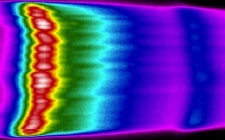 |
Date Announced: 18 Sep 2012
Imaging technology helps researchers working on designs for high-speed aircraft and atmospheric re-entry of space vessels.
An applications report from FLIR Systems details how the Aerospace Research Group at the University of Manchester (UK) are using a FLIR SC655 thermal imaging camera to test models and aircraft components subjected to hypersonic airflows.
For the purpose of space exploration and aircraft technologies, researchers are exploring travelling at hypersonic speeds, which entails attaining speeds higher than Mach 5, more than five times the speed of sound. This puts a huge strain on the aerodynamic and thermal designs of vessels and components.
Travelling at hypersonic velocities, massive airflows would rush past a vessels surface, causing friction, which in turn causes a rise in temperature. To test components and their capability to withstand airflows at such velocities, the University of Manchester researchers have combined their hypersonic wind tunnel with a FLIR SC655 thermal imaging camera.
According to Professor Konstantinos Kontis, head of the Aerospace Research Group at the University of Manchester "We chose the FLIR SC655 because it is capable of recording thermal maps of the entire surface of the test object". He added "It has an excellent thermal sensitivity, so it allows us to record tiny temperature differences. With the external triggering options and high speed video capturing capabilities it is the perfect tool for this type of test." To capture the thermal footage and perform the initial analysis of the temperature data the Research Group have used FLIR ResearchIR software.
The Aerospace Research Group believe that knowledge gained by these wind tunnel tests will help enhance designs for high speed aircrafts and re-entry space vessels that need to be capable of bringing payloads to orbit and returning to the Earth's surface more or less intact. "The FLIR SC655 thermal imaging camera is a crucial tool for these developments, which will lead to better version of hypersonic craft like the Boeing X-5 and the NASA X-43", concluded Professor Kontis.
To download and review a copy of the application report in full please visit this URL.
The FLIR SC655 thermal imaging camera contains an uncooled microbolometer detector that produces thermal images at a resolution of 640 × 480 pixels and a thermal sensitivity of 50 mK (0.05 °C). The full resolution can be captured at a frame rate of 50 frames per second (fps), but it also provides high-speed windowing modes that allow the operator to increase the frame rate to 200 fps with a resolution of 640×120 pixels. Fully compliant with both GenICam and GigE Vision protocols, the SC655 is relatively easy to integrate with a variety of third-party analysis software packages.
Source: FLIR ATS
E-mail: research@flir.com
Web Site: www.flir.com
| © 2025 SPIE Europe |
|